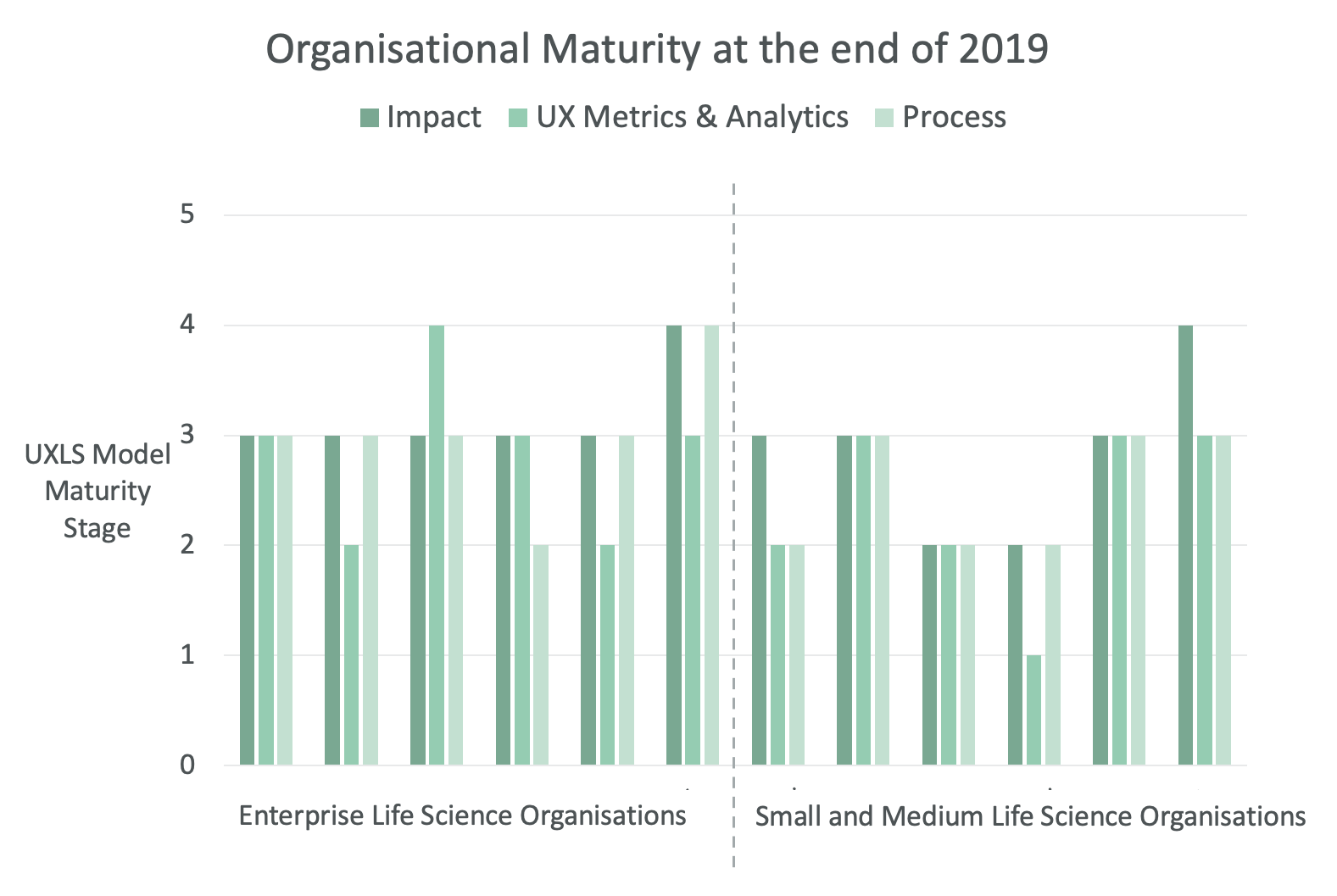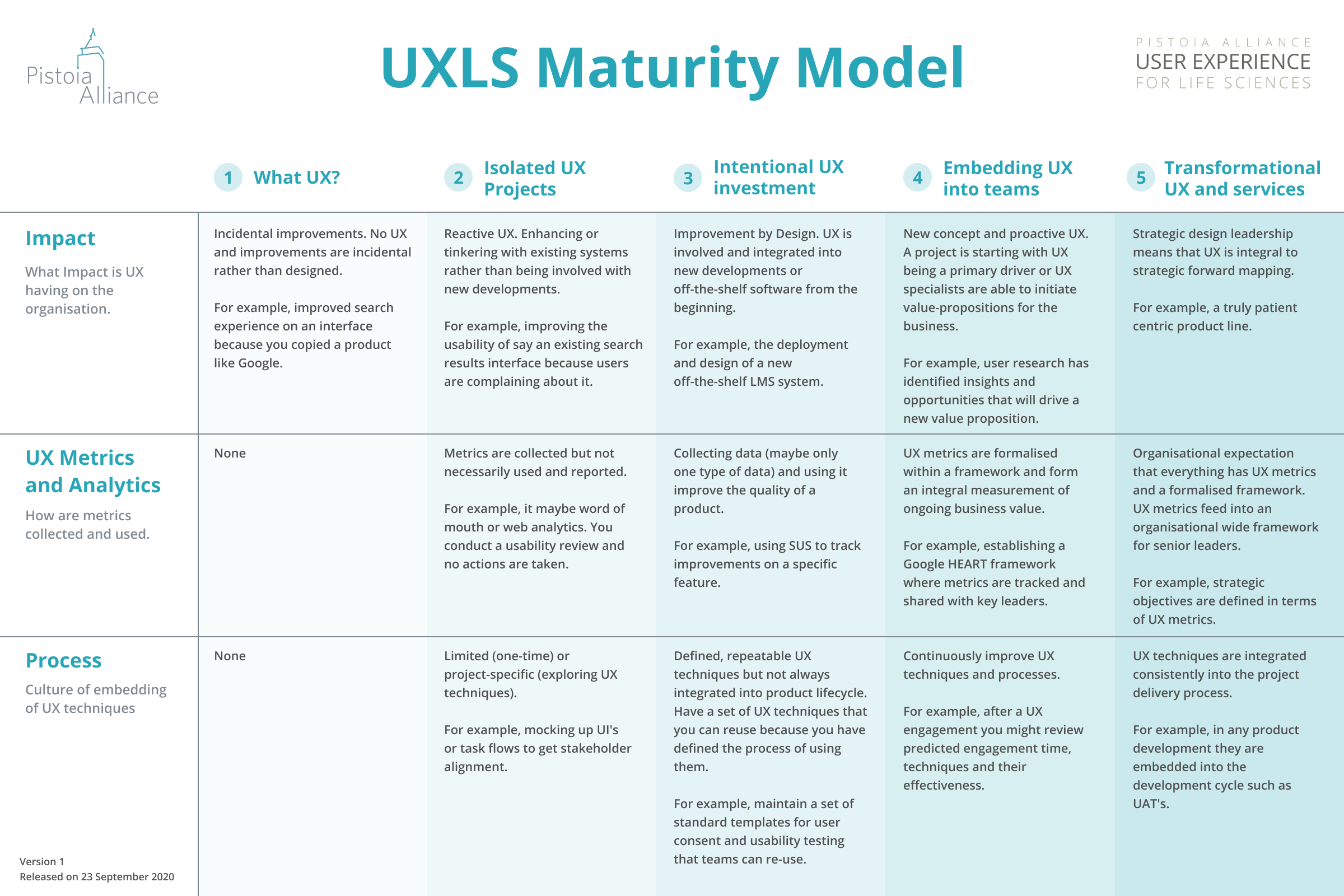As UX becomes a part of the DNA of our member companies it has become important for companies to understand the trajectory they are on and what the north star will look like for a user-centered design culture. The UXLS project team have designed a UX maturity model specifically relevant to Life Sciences to support companies wanting to assess their place on this journey.
Why do we need maturity models?
Maturity models are a useful tool to allow colleagues in an organisation or product team to have a frank discussion about the current status of the company’s user-centricity and their current UX capability. Moreover it allows colleagues to clarify their ambition when it comes to further integration of UX activities. The maturity model gives a framework to allow companies to plan their next steps and identify what they need to be achieving to move to the next stage.
What is the UXLS Maturity Model?
There are of course many UX maturity models out there and they have value. As a UXLS project team we felt it was valuable to develop our own using the dimensions that were of value in the Life Sciences domain and tuned to the specific needs of our industry
The main dimensions chosen for the UXLS Maturity model reflect the special attention given to these dimensions specifically in the life sciences.
- Impact – What impact is UX having on the organisation or area?
- UX Metrics and Analytics – How are metrics collected and used? A systematic and iterative approach to measuring UX is something many organisations aspire to.
- Process – How are UX methodologies embedded into organisational or team processes.
For each dimension we have identified 5 different stages of maturity from a low level 1 of maturity to a higher level 5.
- What UX describes a state where there is little or no existence of UX at any of the dimensions.
- Isolated UX projects may have several UX projects running independently of each other. Much of this UX work may be reactive UX in the sense that teams are reacting to poorly designed solutions by bringing UX design into their delivery.
- Intentional UX investment reflects a state where the organisation starts to value and invest in UX capacity.
- Embedding UX into teams means that UX is now a part of each project delivery team and is proactively engaged from the beginning of each project.
- Transformational UX and services involves a higher level of UX engagement from senior leaders whereby UX is part of the company’s strategy and business value.
You are free to use and adopt the UXLS Maturity Model under the same terms of use released in the UXLS toolkit.
How to use the UXLS Maturity Model?
There are many ways that you can use the maturity model. We suggest that colleagues individually assess their companies maturity providing comments or evidence for their assessment. Once all assessors have completed we recommend that you have a facilitated discussion around each dimension sharing why you have ranked your company in such a way. It is important to note that there is no right or wrong answer here and the discussion around your company’s maturity is the most valuable outcome.
Furthermore it is important to discuss with your senior leadership where your company aspires to be and what that aspiration looks like. What sort of investment and cultural changes are required for that aspiration. Consider setting a target maturity level and a timeframe in which to achieve it.
This is a worthwhile exercise to perform periodically to remind everyone of where your organisation wants to be.
The UXLS Maturity Model in action
In the UXLS project community we use the UXLS Maturity model as a means to compare our organisational maturity and how we are faring against other similar types of organisations.
Our article entitled the Evolution of User Experience for Life Sciences illustrates how we are able to use maturity models to understand the UX landscape. It also helps identify trends that perhaps maybe expected such as smaller organisations who are able to mature faster than larger organisations. We regularly use the UXLS Maturity Model within the UXLS project team to evaluate the evolution of UX maturity in our organisations.

Figure 2: Maturity measured in January 2020 for 12 biopharmaceutical, agri-food, academia and industry-associated software vendors, using the in-house developed UXLS maturity model across the dimensions of Impact, Process and UX Metrics and Analytics.
Acknowledgements: We would like to thank Joel Miller (Amgen), Andre Richter (Bayer) and Olga Kruglova (formerly Lifebit) for their contribution to this model. We would also like to thank Matan Berson (Benchsci) for his design help.
Authors: Santiago Viteri, Simon Fortenbacher (GSK)

